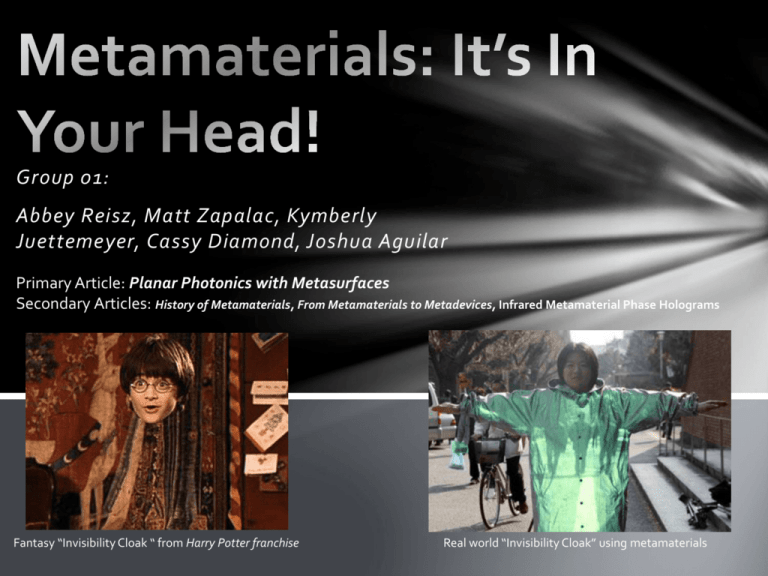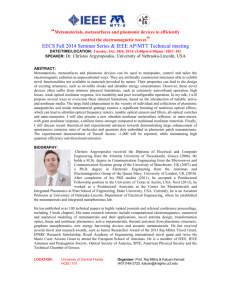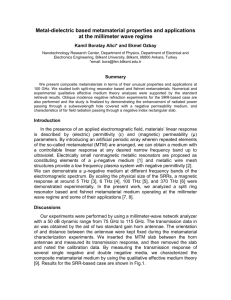Metamaterials - Artie McFerrin Chemical Engineering Department
advertisement

Group 01: Abbey Reisz, Matt Zapalac, Kymberly Juettemeyer, Cassy Diamond, Joshua Aguilar Primary Article: Planar Photonics with Metasurfaces Secondary Articles: History of Metamaterials, From Metamaterials to Metadevices, Infrared Metamaterial Phase Holograms Fantasy “Invisibility Cloak “ from Harry Potter franchise Real world “Invisibility Cloak” using metamaterials Summary of Research • What are metamaterials? Why are they relevant? • History/Background • Core Concepts/How They Work • Applications • Assessment of Metamaterials • Conclusions Picture: Metamaterials Google.com Negative index metamaterial array configuration, which was constructed of copper split-ring resonators and wires mounted on interlocking sheets of fiberglass circuit board. • What are “metamaterials”? Why are they unique? Material that gains properties from its surroundings rather than composition of material • “Magnetoelastic” material-have a mechanial degree of freedom that allows mutual interaction with its surroundings to enable electromagnetic forces to change the structure and tune its properties; they respond to light, acoustic waves, and heat flow. • Negative permeability, permittivity, refractive index, which are usually positive in other materials • Reduced dimensionality and bulk; planar, ultrathin • Controls light waves, acoustic waves, heat waves • Regular material constraints lifted Research and Picture: Planar Photonics with Metasurfaces Alexander V. Kildishev et al. Science 339, (2013); DOI: 10.1126/science.1232009 http://www.sciencemag.org The 8 V-shaped prongs represent one unit cell that repeats through the structure; these help demonstrate negative refractive index and reflection angles that give the material its unique physical and optical properties. History/Background of Metamaterials • What is light? • • A magnetic and electric wave propagating together to create an electromagnetic wave. Magnetic field wave and electric field wave propogating perpendicular to one another; metamaterials are affected by light, which is electric and magnetic waves. James Maxwell-made the connection between light, electricity, and magnetism in the 1800’s; electromagnetic field Ordinary electrical charges produce field lines that spread to infinity in empty space. Research: Research Top Picture Bottom Picture History of Metamaterials Reed Business Information January 8, 2011 http://www.tmcnet.com History of Metamaterials Wikipedia.com http://www.astronomynotes.com Electromagnetic Field Google.com History/Background of Metamaterials A diagram of Snell’s Law showing the relationship between angle of incidence and refraction. Refraction of light at the interface between two media of different refractive indices, with n2 > n1. Since the velocity is lower in the second medium (v2 < v1), the angle of refraction θ2 is less than the angle of incidence θ1; that is, the ray in the higherindex medium is closer to the normal. • Victor Veselago-discovered negative refractive index in 1967 • Electric and magnetic fields aligned in opposite directions; the reversal of Snell’s Law would “bend light the wrong way” • “Meta” means “beyond”, which was given as a name to this material because it is “beyond conventional materials” Victor Veselago’s proposal of negative refractive index and negative reflection of light on a metasurface Research: Research Top Picture Bottoms Pictures: History of Metamaterials Reed Business Information January 8, 2011 http://www.tmcnet.com History of Metamaterials Wikipedia.com Snell’s Law Wikipedia.com Planar Photonics with Metasurfaces Alexander V. Kildishev et al. Science 339, (2013); DOI: 10.1126/science.1232009 http://www.sciencemag.org History/Background of Metamaterials • John Pendry • Discovered that radiation absorption does not come from the chemical or molecular structure, but comes from carbon fiber shape within material. • Discovered negative permittivity and permeability • Created the “split ring structure” with repeating thin wire structures sequentially. • David Smith-created the first metamaterial in 2000 capable of bending electromagnetic radiation; went on to create first invisibility cloak. • Today, we have “active “ metamaterials that control and respond to surroundings. Top: Split ring structure before the electromagnetic field is applied Bottom: Electromagnetic field applied; lattice parameters change. Research: Research Bottom Picture History of Metamaterials Reed Business Information January 8, 2011 http://www.tmcnet.com History of Metamaterials Wikipedia.com Planar Photonics with Metasurfaces Alexander V. Kildishev et al. Science 339, (2013); DOI: 10.1126/science.1232009 http://www.sciencemag.org Core Concepts: Electromagnetics • Light is a direct result of electric and magnetic waves propagating together. • An electromagnetic wave showing electric field Є and magnetic field H components and the wavelength λ. Permittivity and Permeability must be simultaneously negative for a metamaterial to exist. • Permittivity: • • The measure of how an electric field interacts with a dielectric medium. Electromagnetic Permeability: • The measure of the ability of a material to support its own magnetic field. Research: Pictures: Permittivity Permeabilitiy Wikipedia.com Fundamentals of Materials Science and Engineering Ch. 19 Energy of particle of light is proportional to frequency by Planck’s Constant. The spectrum of electromagnetic radiation; metamaterials are not visible to the human eye and the waves absorbed by metamaterials are typically found in the microwave and infrared region, although all waves are a form of electromagnetic radiation. Core Concepts: Refractive Index • Refractive Index (n) • Describes how light propagates through a medium. • Less than 1 • Can be positive…(normal materials) • Or negative (metamaterials) • Wave front can travel towards direction of source • A video showing negative refractive index: Refractive index: speed of light over the phase velocity of a given substance. Є is permittivity and μ is permeability; in order for refractive index to be negative, both of the others must also be negative. http://upload.wikimedia.o rg/wikipedia/commons/c/c 7/Negative_refraction.ogg Illustration of a negative refractive index Research Research and Picture Negative Index Metamaterials Wikipedia.com Using Metamaterials to Defy Our Common Understanding of Light http://www.rikenresearch.riken.jp Core Concepts: Acoustic • Inherent parameters of the medium are the mass density ρ, bulk modulus β, and chirality k. • • Chirality determines the polarity of wave propogation. Requires negative bulk modulus and mass density; these must be altered to define the refractive index of a Bulk modulus: A diagram of uniform compression. This is possible through negative refractive index and chirality of metamaterials. Negative bulk modulus means that the medium expands when experiencing compression, and accelerates to the left when being pushed to the right. material. • • Bulk modulus is the resistance to uniform compression. Allows unique effects such as a The relationship between refractive index (n), mass density (ρ) and bulk modulus (β). inverse Doppler effect Research Further Research and Pictures: Double-negative acoustic metamaterial Jensen Li and C. T. Chan Science 339, (2013); DOI: 10.1103/PhysRevE.70.055602 http://pre.aps.org Acoustic Metamaterials Wikipedia.com Applications of Metamaterials: Invisibility • Negative refractive index is crucial • Makes the path of light quicker around an object rather than through it • Bend electromagnetic waves around an object, rendering it invisible. • “Perfect” invisibility not yet A diagram of how light (microwave source) affects normal objects and metamaterials differently. possible, but partial invisibility (translucency) is proven. Research: Diagram: Photo: How Invisibility Cloaks Work William Harris and Robert Lamb Howstuffworks.com Super-Technologies Theonematrix.com “Is the Army Testing an Invisible Tank?” Alexander Nemenov/AFP/Getty Images http://www.howstuffworks.com/invisible-tank1.htm Potential to create an armor for soldiers that would render them and their shadows invisible. Applications of Metamaterials: Invisibility • Allows: • Invisibility cloaks • Stealth paint on planes • See through gloves for surgeons • Take away blind spots for drivers in cars • Virtually anything in the military ranging from clothes for soldiers to invisible planes A person wearing a real “invisibility cloak” made of metamaterials Pictures: Google.com The type of plane that would benefit from metamaterial cloaking; stealth attacks and landing would be much easier and safer. Applications of Metamaterials: Subwavelenth Imaging and Superlenses • What is a superlens? • • • • Subwavelength images via metamaterials allow to see cells in real time in natural environment Can see patterns which are too small to be seen by conventional microscopes Research: Research: From metamaterials to metadevices Nikolay I. Zheludev and Yuri S. Kivshar Nature Materials 11, 917-924 (2012) DOI: 10.1038/nmat3431 23 October 2012 Superlens Wikipedia.com Goes beyond diffraction limit • Most lenses limited by imperfections • Superresolution Microwave frequencies An example of how molecules would look with subwavelength imaging. Top Picture: Bottom Picture: The Superlens Nature.com Google.com Applications of Metamaterials: Wireless • Metamaterial is placed between the Power Transmission transmitter and the receiver would create a kind of lens, directing the energy so that most of it gets to the device being charged. • This metamaterial would use thousands of individual thin conducting loops that would be tailored to recipient device. How the charging cycle works through the flow of electricity and wireless power. • Space between the charger and chargee effectively disappears. • Short range mobile devices are an easy feat, but electric vehicle charging and more is a new possibility. Current electric automobile charging device; can someday have the charger at a further distance. • Perhaps the device could be created inside the car to self-charge anywhere. Research Research Pictures Metamaterials: Wireless Power Gizmag.com Noel McKeegan May 25, 2011 Artificially Structured Metamaterials May Boost Wireless Power Transfer Sciencedaily.com March 12, 2012 Wireless Charging Metamaterials Google.com Applications of Metamaterials: Holographic Images • Artificial structuring is represented by diffractive optics, which control a wave through multilevel diffractive devices. • • Process Flow for the fabrication of the multilayer metamaterial hologram Gerchberg-Saxton iterative algorithm • Relationship between complex transmittance and of the hologram and the far-field image generated • Iteratively adjusts the constraints in the hologram and the image to focus. Metamaterials are crucial for holographic images because of the metal inclusions that are strong scatterers of electromagnetic waves and provide a large electric polarization. • Provides a magnetic response and controlled anistrophy (directional dependence of waves) Research and Photo: Photo: Rendering Infrared metamaterial phase holograms Stephane Larouche, Yu-Ju Tsai, et al. Nature Materials 11, 450-454 (2012) DOI: 10.1038/nmat3278 18 March 2012 “Infrared metamaterial phase holograms” http://nextbigfuture.com/2012/03/infraredmetamaterial-phase-holograms.html#more Artistic rendering of a section of metamaterial hologram demonstrating the various metamaterial elements used. The hologram consists of three layers of gold elements in a SiO2 matrix over a Ge substrate. Applications of Metamaterials: Holographic Images • Could render perfect holograms on a 2D display. • So accurate that you can look into it with binoculars and still not be able to tell it’s a holographic image. A fantasy hologram from the Star Wars franchise; an idea of how holograms could eventually look. • Infrared region (10.6 micrometers) • Can be applied to videogames, television, military, graphics in general Duke University’s metametarials hologram; the E was not formed due to grazing incidence. Research: Top Picture: Bottom Picture: Infrared metamaterial phase holograms Stephane Larouche, Yu-Ju Tsai, et al. Nature Materials 11, 450-454 (2012) DOI: 10.1038/nmat3278 18 March 2012 Google.com Holograms Nature.com Applications of Metamaterials: Terahertz Biosensors • Can identify a chemical or biochemical molecular composition even very minute amounts • Increased sensitivity and facilitated readout • Sense the dielectric properties of a sample in the terahertz frequency range (a) Schematic of the micrometer-sized metamaterial resonators sprayed on paper substrates with a predefined microstencil; (b) Photograph of a paperbased terahertz metamaterial sample; (c) Optical microscopy image of one portion of a paper metamaterial sample. Research and Picture: Metamaterials Application in Sensing Tao Chen, Suyan Li, Hui Sun www.mdpi.com DOI: 10.3390/s120302742 29 February 2012 Applications of Metamaterials: Biosensors • Biosensors : disease diagnostics, • Need for bioanalytical sensing techniques that can environmental monitoring, food directly detect the target molecules without labeling safety, and investigation of •Technologies based on metamaterials provide costefficient and label-free biomolecule detection biological phenomena • Used to improve the sensor selectivity of detecting nonlinear substances • Can improve the mechanical, optical and electromagnetic properties of sensors Allows to detect analytes (biomolecules) in volumes down to attoliters; single particle measurements probe the local environment around one specific particle. Research Image: Metamaterials Application in Sensing Tao Chen, Suyan Li, Hui Sun www.mdpi.com DOI: 10.3390/s120302742 29 February 2012 "Biosensing Using Gold Nanorod Metamaterials." All About Biosensors. N.p., n.d. Web. 06 Apr. 2013. TEM micrographs of gold nanorods with mean aspect ratio 2.8. Applications of Metamaterials: Communication • Need to keep the antenna size • within specific size or foot print • Metamaterials used to minimize surface waves arising from micro strip patch antennas • • Goal: Increase the gain of the The MSRR unit cell is to have POSITIVE values for the effective permeability and permittivity at the resonance frequency of the antenna Shows the gain of the micro strip antenna before and after using the artificial magnetic superstrate. The gain improved by 3.4 dB at the resonance frequency after using the engineered superstrate. This means the efficiency of the antenna at the operating frequency of 2.2GHz increased by 17% due to the metamaterial superstrate. Magnetic superstrates that use split ring resonators (MSRR) inclusions micro strip antenna while maintaining its low attractive, low profile features A planar 10X10 array of MSRRS was printed on the hose dielectric layer to provide the engineered magnetic material. The superstrates used here consists of 3 layers of printed magnetic inclusions, separated by 2 mm of air layers. Research Metamaterials Application in Sensing Tao Chen, Suyan Li, Hui Sun www.mdpi.com DOI: 10.3390/s120302742 29 February 2012 Images : O. M. Ramahi, M. S. Boybay, O. Siddiqui, L. Yousefi, A. Kabiri, Hussein Attia, M. Bait-Suwailam and Z. Ren, "Metamaterials: An Enabling Technology for Wireless Communications," Proceeding of International Conference on Communication Technologies ICCT2010, Riyadh, Saudi Arabia, Jan. 18-20, 2010 Applications of Metamaterials: Superconductors • Often made of niobium • Limited to microwave and terahertz spectral domains • Switch from plasmonic excitations to quantum excitations • Can control magnetic fields • Provide lower losses with better sensitivity Periodic table data for Niobum Diagram of a terahertz metamaterial superconductor. Research: From metamaterials to metadevices Nikolay I. Zheludev and Yuri S. Kivshar Nature Materials 11, 917-924 (2012) DOI: 10.1038/nmat3431 23 October 2012 Top Picture Bottom Picture: Periodictable.com Terahertz nonliner superconducting metamaterial Apl.aip.org Assessment of Metamaterials • Cost efficient • Low cost manufacturing • Less bulky, planar structure • Can affect many different types of A man wearing a metamaterial shirt that allows him to appear translucent. waves: optical, acoustic, heat, infrared, magnetic field, electric • Unlimited combinations with other materials • Unlimited possibilities with a structure that adapts to external stimuli Picture: Google.com Metamaterials with unique mechanical properties. A team there has designed materials with “negative compressibility” that in theory will compress when they are pulled and expand when they are compressed. Picture: Mechanical Properties “New ‘Mechanical Metamaterial’ Expands When You Compress It, Shrinks When your Stretch It” http://www.popsci.com/technology/article/2012-05/new-mechanicalmetamaterial-expands-when-you-compress-it-shrinks-when-you-stretch-it Further Suggested Research • Other applications • Future applications • Integration/hybridization of metamaterials with natural materials Picture: nature.com The many different types of metamaterials • How to improve metamaterials • Commercial uses • More capabilities of metamaterials Conclusions • Negative refractive index can change the structure of metamaterials • Electricity, magnetism, light, heat can all affect a material • Structures can change based on surroundings • Main applications include the superlens and invisibility cloak, but open doors to many other fields and possibilities. Picture: Metamaterials Google.com A metamaterial that could allow wireless power transmission.


